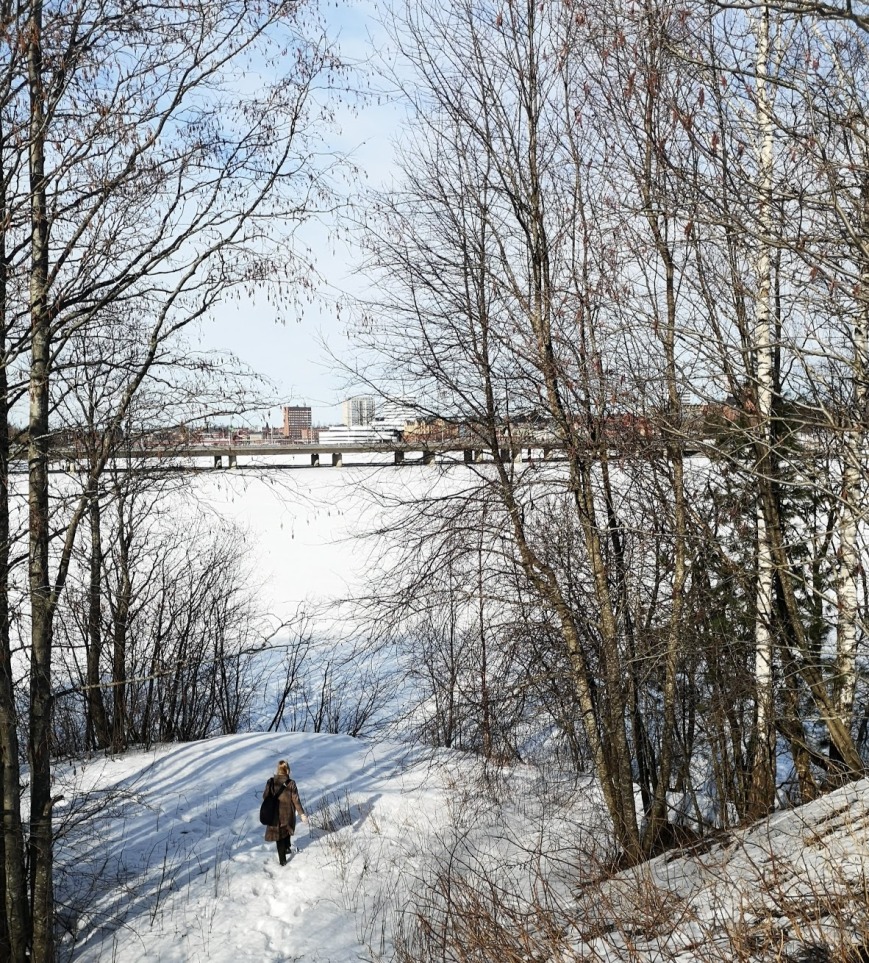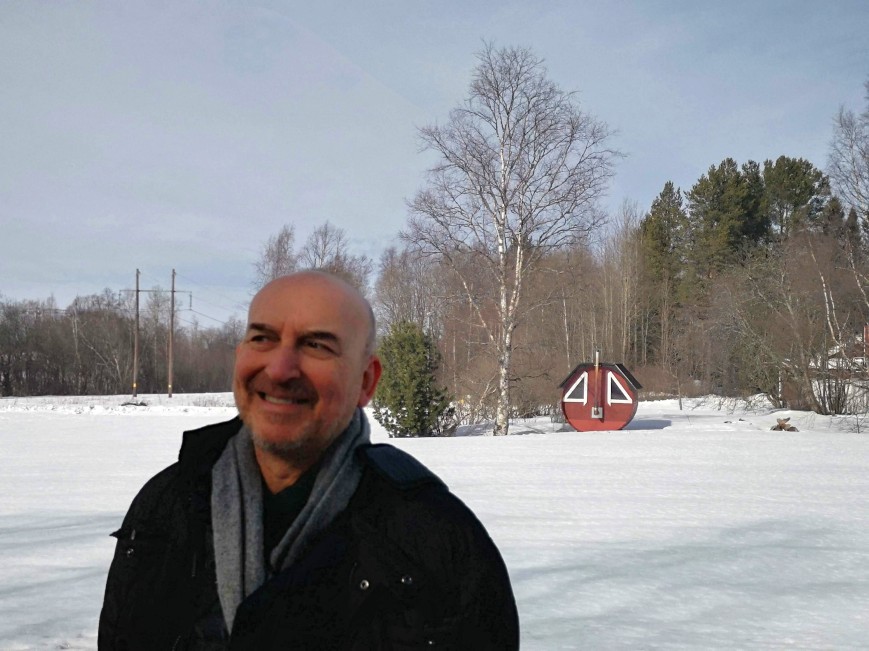 SJ overnight train, Stockholm- Umeå
SJ overnight train, Stockholm- Umeå Walk to the Island, Umeå, 27 March (Shopping cart dilemma)
Walk to the Island, Umeå, 27 March (Shopping cart dilemma)
NORDIC HAZARDLANDS AT UMA, UMEÅ. Host University, UMA School of Architecture. UMA: Ana Betancourt, Rector with Marie Kraft, Lecturer. Symposium: On the Frontier of Mental and Spatial Change in the Swedish – German Countryside(s) Symposium conceived by Daniel Urey -project coordinator-LABLAB with the support of the Goethe Institute Sweden. NORDIC HAZARDLANDS is the 4th in a series of workshops developed for R-Lab at the Royal Institute of Art Stockholm. For the academic year 2018-2019, R-Lab is conducting Marvels and Catastrophes, a post-graduate advanced research group focusing on real and imagined disasters, and their consequences for the future of the planet. Course Instructor: Peter Lang, Professor Architectural Theory and History, the Royal Institute of Art, Stockholm. The R-Lab group was based in Umeå from the 26th to the 29th of March (confined to the Old Prison) and explored the city and produced for its workshop “the Almanac of Marvels and Catastrophes 2019-2020.” See Below for images and descriptions.

 Peter Lang and Anna Asplind assessing the gradual sinking of the shopping cart…
Peter Lang and Anna Asplind assessing the gradual sinking of the shopping cart…
 Untitled (shopping cart, R-Lab)
Untitled (shopping cart, R-Lab)
 Snow sun dial melting through ice floor while casting shadow.
Snow sun dial melting through ice floor while casting shadow.
 Anna Risell approaching the nose of the island.
Anna Risell approaching the nose of the island.
 Jerome Malpel and Orestis Nikolaidis in an ad-hoc interview.
Jerome Malpel and Orestis Nikolaidis in an ad-hoc interview.
 Daniel Urey presenting On the Frontier of Mental and Spatial Change in the Swedish – German Countryside(s) Symposium
Daniel Urey presenting On the Frontier of Mental and Spatial Change in the Swedish – German Countryside(s) Symposium
 Dr. Marta Doehler-Behzadi, Director at IBA Thüringen, Germany
Dr. Marta Doehler-Behzadi, Director at IBA Thüringen, Germany Front row: Madeleine Eriksson, Associate Professor, Department of Geography
Front row: Madeleine Eriksson, Associate Professor, Department of Geography
 From Left to Right: Daniel Urey, Marie Kraft, Madeleine Eriksson, Peter Lang and Marta Doehler-Behzadi.
From Left to Right: Daniel Urey, Marie Kraft, Madeleine Eriksson, Peter Lang and Marta Doehler-Behzadi.
 Anders Jansson, Museum Curator, Bildmuseet, Umeå, walking us through “Entangle, Physics and the Artistic Imagination.”
Anders Jansson, Museum Curator, Bildmuseet, Umeå, walking us through “Entangle, Physics and the Artistic Imagination.”
 Moment of relaxation, Bildmuseet, Umeå.
Moment of relaxation, Bildmuseet, Umeå.
 Peter Lang. in front of a barrel sauna.
Peter Lang. in front of a barrel sauna.
Working session on Almanac, Umeå, 28/03/2019

Working session on Almanac.

Working session on Almanac.
Meaningful Schedule Update for the Umeå Workshop & Seminar:
THIS JUST IN:
Norrlandsoperan= E|A|S – Evolving Asteroid Starships
DSTART (TU Delft Starship Team) is a multidisciplinary team of engineers, scientists, architects and artists developing next-generation concepts for interstellar exploration. DSTART aims to critically explore ideologies underpinning space exploration paradigms, and tries to propose alternative concepts.
The installation in Vita Kuben was created by Nils Faber, Anton Dobrevski, Amélie Kim, Joris Putteneers, Sharon van Rijthoven, Angelo Vermeulen, Arise Wan and Jasper Wennekendonk.
The hostile and unpredictable environment of deep space requires a new conceptual approach for interstellar flight, one that differs radically from any current design in aerospace. Using biology as inspiration, E|A|S suggests creating starships that physically grow and evolve during their journey. Resources extracted through asteroid mining are used to 3D print new components of the ship in an almost endless process of adaptation. The DSTART team is currently developing concept studies and computer simulations to test these ideas.
The proposed art installation is a combination of a large-scale animated video, a composition of flat screens with moving and still images, and a living plant sculpture. The animations and still images are visual studies of the E|A|S project
Located in the middle of Umeå you’ll find the cultural institution Norrlandsoperan. Since its foundation in 1974, Norrlandsoperan has developed from a regional opera ensemble into a centre for performing arts. Still with a regional reach.
Norrlandsoperan includes Norrlandoperan Symphony Orchestra and departments for opera, dance, music and contemporary art. In house we have four stages, production workshops, studios and our own ticket office.
Symposium 27 March, 13:00 – 16:00, Umea @UMA
With support from: UMA, KKH, LABLAB, and the Goethe Institute.
On the Frontier of Mental and Spatial Change in the Swedish – German Countryside(s)
Biographies: (incomplete)
Biographies: (incomplete)
Dr. Marta Doehler-Behzadi
Internationale Bauausstellung Thüringen. 1975 – 1980 Studied urban planning at the School of Architecture and Construction in Weimar (today Bauhaus University Weimar). Dr. Doehler-Behzadi collaborated between 1984 – 1991 in the office of the chief architect of the city of Leipzig and from 1992 – 2007 she was freelance city planner, office for urban projects in Leipzig with Prof. Iris Reuther. Between 2007 – 2014 Doehler-Behzadi was Head of the Department of Building Culture and Urban Heritage Protection in the Federal Ministry of Construction and since 2014 managing director of the International Building Exhibition Thuringia.
Marie Kraft
Marie Kraft is an architect, urban researcher and multidisciplinary artist. Born in Sweden, she lives and works between France, Italy and Sweden. She studied architecture at Ecole d’architecture Paris La Seine, theatre and cinema at Sorbonne University and she holds a Master in Urban research at Ecole des Hautes études en sciences sociales in Paris. Her practice is developed between artistic interventions, social engagement and urban development.She was a cultural project manager at the Swedish Institute in Paris 1994-2017. Since 2018 she is a lecturer at Umeå school of architecture and she is been involved in education of children, professional architects, urban planners and real estate holders. Her current research focuses on reuse of urban heritage and its relation to urban regeneration
Peter Lang
Peter Lang is professor in Architectural Theory and History at the Royal Institute of Art, Stockholm, where he conducts post-graduate and pre-doctorate research courses in architecture, design and multimedia communications. Lang holds a Bachelor in Architecture from Syracuse University and earned a PhD in Italian history and urbanism at New York University in 2000. He is a Fulbright recipient in Italian studies. Lang works on the history and theory of post-war Italian architecture and design, with a focus on sixties Italian experimental design, media and environments. Lang has written and curated a number of projects on the Italian Radical Design and Architecture movement. He has been a member of the Rome based urban arts research group Stalker since 1997.
Daniel Urey
Daniel Urey is the Head of LABLAB research & design think tank at the architect studio ARKLAB, based in Stockholm. Before LABLAB he was engaged in developing the international urbanisation programs at the contemporary art centre Färgfabriken. Daniel Urey has experience working in the Baltic Sea Region, the Balkan’s, Middle East and East Africa. Daniel Urey has an academic background in European Politics, Art History and Philosophy.

Fargfabriken: Updated December 20, 2018.


